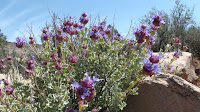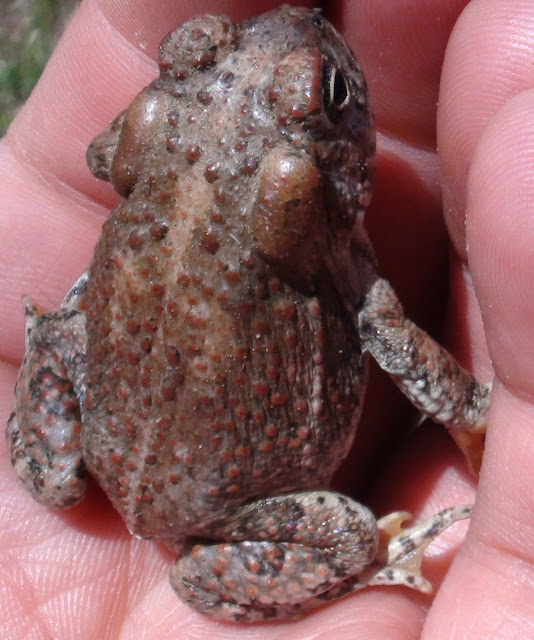 |
| Only about an inch long. |
Ah, there is nothing better than that tangible tingle in the air as the frozen lock-grip of winter begins to change to the warming glow of spring. The possibilities begin to dance rather obtrusively in the foreground of my mind of all the herping yet to get done. The Herpin boys and I head down to Arizona, along the Colorado River to kick things off proper. We did some spearfishing, and that was nice, but the real excitment came from the great Arizona desert. I woke up the second day with a surprise inside my mess kit pot. Sitting in the bottom of this seemingly impassible stainless steel pitfall, was a Solifugid. These arachnids are also known as 'Sun spiders', 'Wind scorpions' and 'Camel spiders' and are amazing creatures. Typically found in desert biotopes, they can also be found in forest and grassland ecotypes. They are non-venomous as a whole and do not spin webs. They are voracious predators, in fact I read an article of a female eating 100 flies, and in doing so she had distended her abdomen to such an extent, she became immobile. They have the appearance of having 5 pairs of legs, however the front pair of "legs" are overgrown pedipalps. These pedipalps are typical in containing sensory organs and additional glue like glands that help secure prey. The front pair of true legs are the smallest, and usually are used to help with sensory duties rather than navigation. They are extremely fast, reaching speeds up to 10 MPH, talk about speed kills! They have a tendency in hotter, sandier climates to "chase" shade, or perhaps the shadow of some poor onlooker. In fact their Latin name, Solifugae, translates to "Those that flee from the sun". Now I have to say the coolest aspect of these cousins to the spiders and scorpions has to be their chelicerae aresenal. They too are over developed, and are more likened to giant torturous steel clamps than that of a body part.The simply cut, rip, tear, pulverize and mash the prey item into a gooey ball, that than is mixed with enzymes and than the juices swallowed. MMMMM BON APETIT!
 |
| Prime! |
 |
| You can see the species' namesake. |
|
 |
| King of his domain. |
Later that morning we went herping....finally! Oh man, was that the right thing to do. We hit this fantastic plateau that was strewed with lots of sand and black lava rocks. Great habitat for a plethora of lizards, such as Side Blotched lizards (Uta stansburiana), Desert Iguanas (Dipsosaurus dorsalis), and common Chuckwallas (Sauromalus obesus ater). To start we saw Side Blotched lizards (Uta stansburiana) everywhere. They were the most abundant lizard hands down. Side Blotched lizards (Uta stansburiana) are a common southwest lizard that have as much range in their color and pattern as they do in color and pattern to their range. These were some of the prettiest I had seen, with mustard yellow through out the ventral area, blue ticking through out the dorsal area, and a overall hue of rusty orange. Even the mites were a brilliant sunflower orange and added to the overall beauty.
 |
| Trying to literally become the rock! |
 |
| 2/3 tail. |
We than came across a Desert Iguana (
Dipsosaurus dorsalis) hotspot, with a few dozen occupying the area. Seeing them was easy, catching them on the other hand, now that was going to be difficult. After some close calls, we finally caught a young female. She was absolutely perfect, and I felt so privileged to hold her. She of course, felt different, and tried to puff up to the size of a Green Iguana (
Iguana iguana). This made it easy to handle her. I was amazed by her coloration, as you can see, the banding of her tail is lost in the reticulation of her body. In the spring both males and females will develop a pinkish hue to their flanks and sides. They are common in the southwest deserts and as such can be found from the north of Mexico to the south of Utah. They love Creosote and it's flowers, other flowering plants and insects. They are incredible burrowers, and can also tolerate extreme heat, and this is noted in their Latin name Dipso = thirsty and Saurus = lizard. They are the only member of their genus, something called Monotypic. When we released this female she gave some insight to some common ground shared by other desert lizards, and that is their propensity toward bipedal movements. She shot off on her hind feet as if to take off like a rocket! We kept moving on, taking note of all the spring flowers and abundant insect life.
 |
| "Indian" Paintbrush |
 |
| Desert Blister Beetles |
 |
| Flowering Sagebrush |
 |
| Tent caterpillars. |
 |
| Desert Marigold with blister beetles. |
The desert was alive, that only left us to stand back and peel back the discoveries. Every where we looked there was something to hold your attention and it made any lateral movement difficult. Eventually however we ended up inside a small wash canyon, and spotted a terrific find. In fact it was a 'Lifer' for me, and I was all too proud and excited to get my hands on the beautiful gem. What we had finally been able to catch was a common Chuckwalla (
Sauromalus obesus ater). She was an adult female in mid shed. She had wedged herself to the rock, but we were able to coax her out. She had some orange spotting on her dorsal area and a strong banding to her tail. There is a beautiful locale in AZ of common Chuckwalla (
Encelia farinosa) that is aptly named the 'Carrot-tailed' Chuckwalla, as the males will display a complete orange tail, that stands out against a jet black body. As always, with most Chuckwallas (
Sauromalus obesus ater), she was placid and docile. More content to just lay still than much else. While female more often than not occupy the territory of a larger more colorful male, we were unable to see him. They are strictly herbivorous and tend to prefer yellow flowers like that of the Brittlebrush (
Encelia farinosa), also known as "Chuckwalla's delight". They are large lizards that are very wary, and most of the time don't allow 100 feet between you and their favorite hiding spot. The trick to catching them is grabbing them before they hit that favorite spot and inflate and essentially become that void, making it impossible to retrieve them.
 |
| Just so cute! |
 |
| Notice how 'Obese' she is! |
As you can see, they are superb, and remind me a lot of the middle-eastern Uromastyx clan, and behave in a very similar manner. These guys are perfectly suited for the harsh heat and can operate at a very high temperature. They belong to a genus with half a dozen members or so, and with all the others isolated to the Baja peninsula and it's islands,
Sauromalus obesus ater, is the most wide-spread of the clan, ranging from California to Arizona and Utah to Mexico.
We head Northward and end up in St. George, Utah, the southwest corner of the state. Through out this trip, we have only seen one live snake! Disgrace! It was a beautiful young Red Coachwhip (
Masticophis flagellum). Too much speed to just sneak up onto, and before we could create an 'effective' plan, that serpent was gone! As the trip was naming itself a lizard trip, I flipped over a rock after a very cold and very wet spent storm and found a beautiful Gopher Snake (
Pituophis catenifer).
 |
| Fantastic, 1 to 2 years old. |
|
|
|
Poor thing was soo cold, I thought she was dead. Thankfully she was just comatose, and soon began to move around with the aid of my warm hands. Later, we find one of the most handsome male Sagebrush lizards (
Sceloporus graciosus) I have ever seen. His undersides were a metallic blue that seemed to shatter your idea of what blue was, it was as if blue was kicked into your eye sockets and tattooed onto your brain. I mean amazing what beauty not only the desert possesses and hides, but nature as well. The top of this male Sagebrush lizard (
Sceloporus graciosus) was pretty bland, with shiny hues of browns and blacks, but the underside was a completely different story. Tell me what you think?
 |
| Ventral |
 |
| Dorsal |
 |
| Notice the large Paratoid glands containing the toad's poison. |
Well as the trip began to reach it end, we were able to catch an old friend of mine, the Red Spotted toad (
Bufo punctatus). These toads are found through out the southwest. They are common in dry riverbeds, and shortly after rain. They are very quick to take advantage of a water source, whether that's a vernal stream or even a puddle. The eggs can hatch in three days and full transformation can take as little as 4 weeks. They are strictly insectivorious and will eat any insect that crosses their path. They are avid callers and males can be heard most nights. Juveniles will have yellow feet, and males will develop the nuchal pads needed to secure a female, and will also develop either gray or yellow coloring to their throats during the breeding season.
Well over all, an amazing kick off herping trip for 2011, hopefully the whole year will be this amazing. Here is hoping for great luck for all of us herpers this year!
Until next time, from one student of nature to the next,
Luka Ohana


















No comments:
Post a Comment